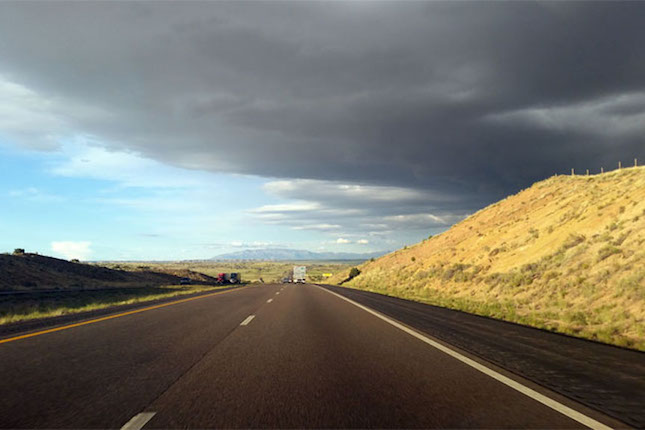
Flying to your destination can be great, but let’s be honest, what’s more fun than an old-fashioned road trip with family or friends? That being said, with any road trip, things can go wrong and none more so than driving through hazardous weather.
At the end of April, the South saw violent storms that led to tornadoes, damaged homes, cars swept away by water, and even five deaths in Texas. Sure, it’s scary to drive through a bad storm, but that doesn’t mean we should deny ourselves a fun road trip that just happens to fall during the rainy season. Even if you never find yourself driving through a stormy area (or already feel like a pro), many of these travel tips may still come in handy.
What to Do Before You Hit the Road
Photo courtesy of Flickr/Paul Shirey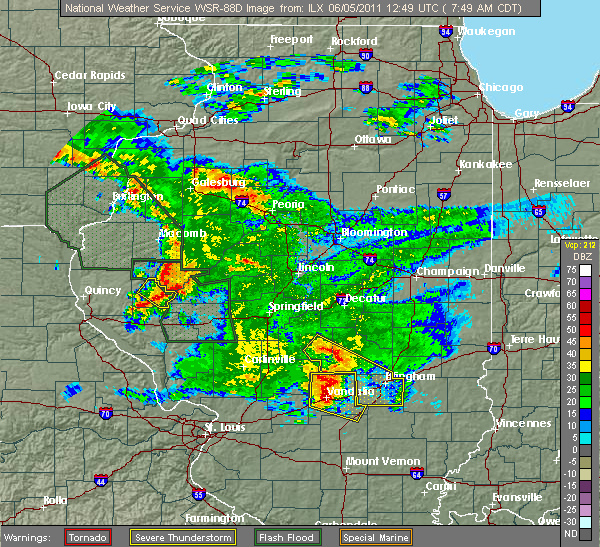
According to meteorologist Jason Meyers, “Meteorologists are able to accurately predict when and where severe thunderstorm outbreaks are most likely to occur between one and three days out over large areas.” Luckily, this makes it easy to prepare for a road trip through stormy weather.
The first thing you’ll want to do is monitor the weather before your trip. It’s best to download a weather app like Storm Shield that tracks storms. If possible, adjust your driving time accordingly. For example, if the storm is expected to hit the area you are driving through in the morning, opt to drive in the evening instead.
As Dr. Anne Case Hanks, the Associate Director of the School of Atmospheric Sciences at the University of Louisiana at Monroe, notes, “Storms move at different rates. It’s best to look at the radar and understand how big a storm is and how fast it’s moving.”
It’s also wise to prepare your car for a trip through stormy weather. This means replacing your windshield wipers, making sure your headlights and tail lights work, adding rain or wind visors or deflectors, and replacing your tires for those with better tread.
What to Do While Driving Through a Storm
Photo courtesy of Flickr/RAVDesigns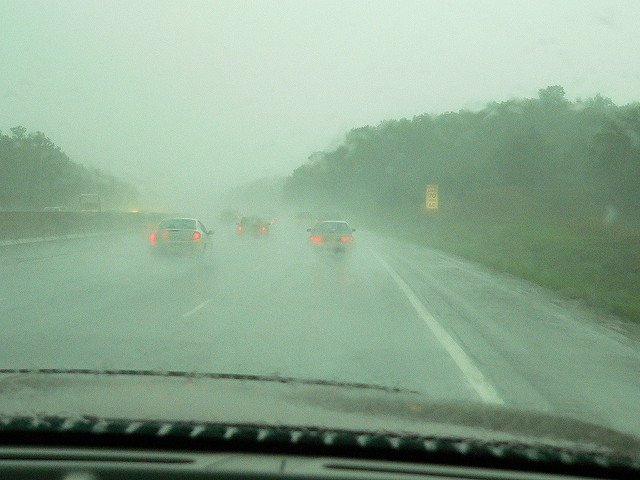
Just a bit of rainfall can make a big impact on your road trip. According to the U.S. Department of Transportation, 22 percent of all crashes are weather-related, 73 percent of those occur from wet pavement, and 46 percent happen due to rainfall.
There are some things one can do when road tripping through a storm to maximize their own as well as their passenger’s safety. For starters, slow down, even on a highway. You don’t want the tires to lose traction on the wet pavement and cause a crash. In addition, avoid cruise control — it doesn’t allow you to control the car as easily.
Next, make sure your headlights are turned on. This allows other cars to easily see you with the decreased visibility caused by rain. Similarly, make space between you and the vehicle in front of you, as it provides time for your brakes to kick in on the slippery road. Also, rid yourself from all distractions, including cell phones and music. Turn the radio to a local station to monitor the storm or play calming music to help you stay focused on the road.
Last but not least, if the rain is so heavy that you can’t see a few feet in front of you, it’s probably safer to find an area to wait out the storm. If you can’t find a truck stop, restaurant, or parking lot and visibility is extremely bad, slowly pull off onto the shoulder of the road and turn on your hazards. Keep your seatbelt buckled in case someone else pulls off as well and doesn’t see you.
What to Do While Driving Through a Tornado
Photo courtesy of Flickr/DallasAngler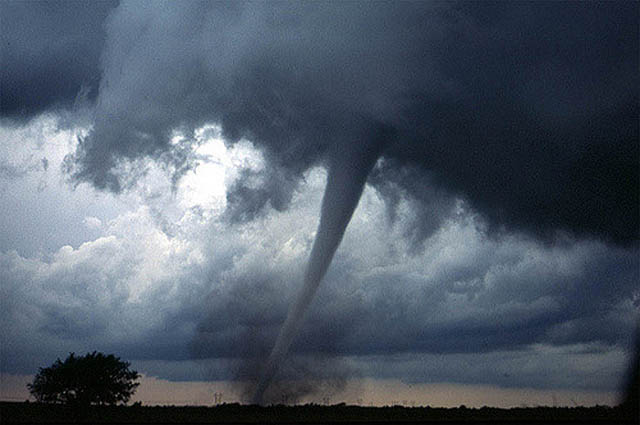
Tornadoes are a scary force of nature. With winds that can reach up to 300 mph and the ability to extend between one and 50 miles long (yes, you read that right!), they leave destruction in their path. So what should you do if you get caught driving through a storm that has the capacity to create a tornado?
“A tornado watch means conditions are right for tornado development. Just keep an eye on the weather and have a plan if a tornado warning is issued,” Meyers says. He strongly urges travelers never drive through a tornado warning, but rather find a building as quickly as possible to take shelter in. Only take shelter in a ditch in the worst case scenario. “Do not [take shelter] under an overpass,” he advises. “The winds are actually worse there.”
Many areas in the south will have sirens that sound when a tornado has been spotted. Pay heed to those alarms. For those areas that may not have sirens, tornado watches and warnings can be monitored with a storm app, on a local radio station, or from the area’s National Weather Service office. “The National Weather Service will provide announcements on their website and social media. [It] will communicate the watches, warnings, and threats to areas,” says Dr. Case Hanks.
What to Do While Driving Through a Hail Storm or Flood
Photo courtesy of Flickr/Claus Rebler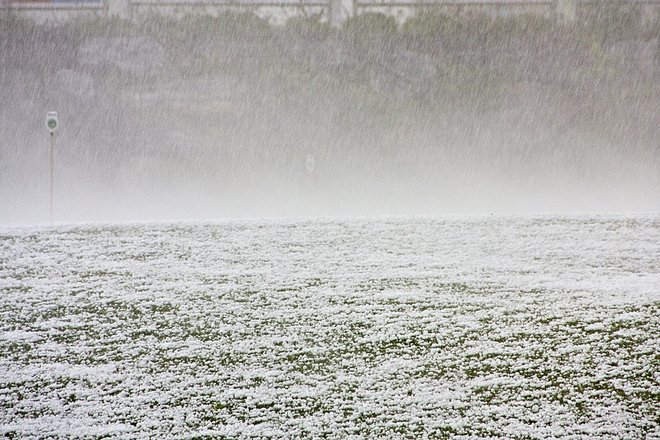
Ever been hit by a baseball? Spoiler alert: it hurts. Now, imagine if that baseball was made entirely of ice and falling rapidly from the sky. According to The Weather Channel, hail ranges from one to four-and-a-half inches. Golf ball to softball-sized hail can smash windshields easily. So, if you’re driving through a thunderstorm that creates hail, it’s best to find a covered area where you can safely park your car to prevent significant damage.
Perhaps the most underrated aspect of driving through stormy weather is flooding. The National Weather Service reported that there were more deaths from floods in 2015 than there were from tornadoes, hurricanes, or lightning. Any storm can bring about flooding. “A typical strong to severe thunderstorm can drop up to an inch or more of rain. If an area is expected to get multiple rounds of thunderstorms, it can get a foot or more of rain, which can lead to flooding,” says Meyers.
If you see a flooded area, do not drive through it. That goes for big trucks, too. Your car can get stuck, go completely underneath the water, or get washed away. As Meyers notes, “It only takes a few inches of water to pick up a vehicle and wash it away,” which would take all the fun out of the trip.
Related Stories:
- 7 Steps to Taking the Best U.S. Winter Road Trip Ever
- A Different Kind of Road Trip: Vancouver to Tijuana in 9 Stops
- 17 Things You Need to Know Before Traveling During Hurricane Season
All products are independently selected by our writers and editors. If you buy something through our links, Oyster may earn an affiliate commission.



